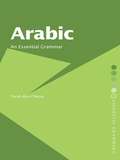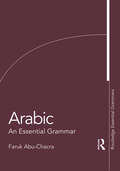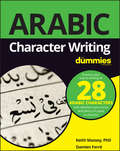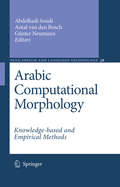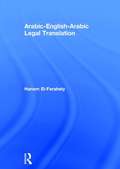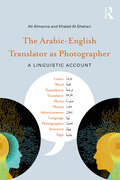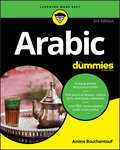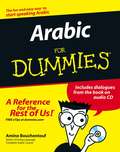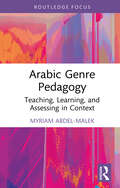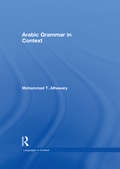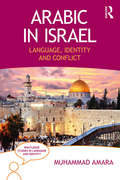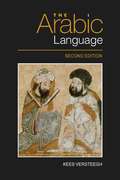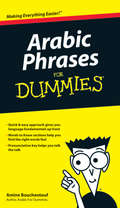- Table View
- List View
The Arab Writer in English: Arab Themes in a Metropolitan Language, 1908-1958
by Geoffrey NashThis book looks at the first generation of Arab British and Arab-American writers to produce English writings in the earlier twentieth-century: Ameen Rihani, Khalil Jibran, George Antonius and Edward Atiyah. It theorises their work within the context of Arab nationalism, postcolonialism and the criticism of Edward Said.
Arabic: An Essential Grammar
by Faruk Abu-ChacraArabic: An Essential Grammar is an up-to-date and practical reference guide to the most important aspects of the language. Suitable for beginners, as well as intermediate students, this book offers a strong foundation for learning the fundamental grammar and structure of Arabic. The complexities of the language are set out in short, readable sections, and exercises and examples are provided throughout. The book is ideal for independent learners as well as for classroom study. Features of this book include: coverage of the Arabic script and alphabet a chapter on Arabic handwriting a guide to pronunciation full examples throughout.
Arabic: An Essential Grammar
by Faruk Abu-ChacraArabic: An Essential Grammar is an up-to-date and practical reference guide to the most important aspects of the language. Suitable for beginners, as well as intermediate students, this book offers a strong foundation for learning the fundamental grammar and structure of Arabic. The complexities of the language are set out in short, readable sections, and exercises and examples are provided throughout. The book is ideal for independent learners as well as for classroom study. Features of this book include: coverage of the Arabic script and alphabet a chapter on Arabic handwriting a guide to pronunciation full examples throughout.
Arabic: An Essential Grammar (Routledge Essential Grammars)
by Faruk Abu-ChacraThis new edition of Arabic: An Essential Grammar is an up-to-date and practical reference guide to the most important aspects of the language. Suitable for beginners, as well as intermediate students, the book offers a strong foundation for learning the fundamental grammar and structure of Arabic. The complexities of the language are set out in short, readable sections, while exercises and examples are provided throughout. Features of this new edition include: coverage of the Arabic script and alphabet a chapter on Arabic handwriting a guide to pronunciation full examples throughout. Ideal for independent learners and for classroom study, Arabic: An Essential Grammar is the complete reference guide to the most important aspects of modern literary Arabic.
Arabic Character Writing For Dummies
by Keith Massey Damien FerréLearn to write in Arabic In Arabic, there are different levels of language. The written language, which is studied in this book, is literary Arabic, sometimes also called classical Arabic or even modern or standard Arabic. It is the language of the Quran, classical poetry, literature and the media. The Arabic plume consists of 28 consonants and three long vowels. Each consonant is accompanied by a vowel which is placed above or below the consonant. Arabic speakers are in great demand in the United States, due to the country's political commitments to the Middle East, but only 25 percent of non-native speakers know the language in enough detail to function as translators, interpreters, analysts, or field agents. Arabic Character Writing For Dummies helps you write this language clearly and correctly. Learn to write the Arabic alphabet Find free instructional videos, flashcards, and printable writing pages online Build upon your mastery of the language Get ahead at work or in your personal life Arabic Character Writing For Dummies is designed for beginners, students, and lifelong learners wishing to write in Arabic.
Arabic Character Writing For Dummies
by Keith Massey Damien FerréLearn to write in Arabic In Arabic, there are different levels of language. The written language, which is studied in this book, is literary Arabic, sometimes also called classical Arabic or even modern or standard Arabic. It is the language of the Quran, classical poetry, literature and the media. The Arabic plume consists of 28 consonants and three long vowels. Each consonant is accompanied by a vowel which is placed above or below the consonant. Arabic speakers are in great demand in the United States, due to the country's political commitments to the Middle East, but only 25 percent of non-native speakers know the language in enough detail to function as translators, interpreters, analysts, or field agents. Arabic Character Writing For Dummies helps you write this language clearly and correctly. Learn to write the Arabic alphabet Find free instructional videos, flashcards, and printable writing pages online Build upon your mastery of the language Get ahead at work or in your personal life Arabic Character Writing For Dummies is designed for beginners, students, and lifelong learners wishing to write in Arabic.
Arabic Computational Morphology: Knowledge-based and Empirical Methods (Text, Speech and Language Technology #38)
by Abdelhadi Soudi Günter Neumann Antal Van Den BoschThis is the first comprehensive overview of computational approaches to Arabic morphology. The subtitle aims to reflect that widely different computational approaches to the Arabic morphological system have been proposed. The book provides a showcase of the most advanced language technologies applied to one of the most vexing problems in linguistics. It covers knowledge-based and empirical-based approaches.
Arabic-English-Arabic Legal Translation (PDF)
by Hanem El-FarahatyArabic-English-Arabic Legal Translation provides a groundbreaking investigation of the issues found in legal translation between Arabic and English. Drawing on a contrastive-comparative approach, it analyses parallel authentic legal documents in both Arabic and English to examine the features of legal discourse in both languages and uncover the different translation techniques used. In so doing, it addresses the following questions: What are the features of English and Arabic legal texts? What are the similarities and differences of English and Arabic legal texts? What are the difficult areas of legal translation between English and Arabic legal texts? What are the techniques for translating these difficult areas on the lexical and syntactic levels? Features include: A thorough description of the features of legal translation in both English and Arabic, drawing on empirical new research, corpus data analysis and strategic two-way comparisons between source texts and target texts Coverage of a broad range of topics including an outline of the chosen framework for data analysis, a historical survey of legal discourse developments in both Arabic and English and detailed analyses of legal literature at both the lexical and syntactic levels Attention to common areas of difficulty such as Shariah Law terms, archaic terms and model auxiliaries Many examples and excerpts from a wide selection of authentic legal documents, reinforced by practical discussion points, exercises and practice drills to encourage active engagement with the material and opportunities for hands-on learning. Wide-ranging, scholarly and thought-provoking, this will be a valuable resource for advanced undergraduates and postgraduates on Arabic, Translation Studies and Comparative Linguistics courses. It will also be essential reading for translation professionals and researchers working in the field.
The Arabic-English Translator as Photographer: A Linguistic Account
by Ali Almanna Khaled Al-ShehariBy choosing to use different linguistic approaches as a theoretical basis of their study of translation as a process of picture-taking, The Arabic-English Translator as Photographer: A Linguistic Account offers readers an original view of the translator’s work. In addition to laying emphasis on the importance of giving full consideration to the mental image(s) conjured up in the mind of the translators, the book provides an accessible introduction to structural semiotics, interpretive semiotics, functional grammar, semantics and cognitive linguistics for students and researchers who are new to the field. The book can be used as a basis for (post)graduate students, especially students of MA and PhD in Translation Studies as well as students in modern languages schools. The book focuses on a specific pair of languages, English and Arabic, and presents the relationships generated by texts’ translation, including adverts and other types of texts, between these two languages.
Arabic For Dummies
by Amine BouchentoufStart reading and speaking Arabic Arabic For Dummies helps readers start speaking Modern Standard Arabic in no time. Whether you’re a student, traveler, or work in business or government, you’ll find this title to be packed with practical lessons, cultural facts, and handy references. Inside, you’ll find guidance on basic grammar, as well as the necessary vocabulary to make introductions and greetings, use proper etiquette, make small talk, make transportation arrangements, order food and beverages, ask directions, deal with money, shop, access recreation, and handle an emergency. Features new and revised content Offers a revamped, user-friendly design to both pedagogy and organization Includes expanded coverage of grammar, verb conjugations, and pronunciations Get free access to conversational audio tracks online If you want to start speaking Arabic, this go-to book is packed with practical instruction, cultural facts, and handy references you won’t want to be without!
Arabic For Dummies
by Amine BouchentoufRegarded as one of the most difficult languages to learn for native English speakers by the U.S. State Department, Arabic is gaining both prominence and importance in America. Recent world events have brought more and more Americans and other English speakers into contact with Arabic-speaking populations, and governments and businesses are increasingly aware of the importance of basic Arabic language skills. Arabic for Dummies provides you with a painless and fun way to start communicating in Arabic. Why should you learn Arabic? Well, besides the fact that over 200 million people in more than 22 nations use it to communicate, there are tons of reasons to get up to speed this 1,400 year old language, including: Nearly all of the Middle-East speaks Arabic or one of its dialects Basic Arabic skills are extremely useful for anyone traveling to, doing business in, or serving in the Middle East It is the language in which the Koran is written There is a rich, centuries-old literary tradition in Arabic Arabic For Dummies presents the language in the classic, laid-back For Dummies style. Taking a relaxed approach to this difficult language, it’s packed with practice dialogues and communication tips that will have you talking the talk in no time. You’ll get the scoop on: The Arabic alphabet, pronunciation, basic grammar, and the rules of transliteration The history of the language and information on classical Arabic and its dialects How to make small talk and make yourself understood when dining, shopping, or traveling around town How to communicate on the phone and in business conversations Handy words and phrases for dealing with money, directions, hotels, transportation, and emergencies Arabic culture and etiquette, including ten things you should never do in Arabic countries The book also includes an Arabic-English dictionary, verb tables, and an audio CD with dialogues from the book to help you perfect your pronunciation. Written by a native Arabic speaker who helped start a year-round Arabic department at Middlebury College, Arabic For Dummies is just what you need to start making yourself understood in Arabic. Note: CD-ROM/DVD and other supplementary materials are not included as part of eBook file.
Arabic For Dummies
by Amine BouchentoufStart reading and speaking Arabic Arabic For Dummies helps readers start speaking Modern Standard Arabic in no time. Whether you’re a student, traveler, or work in business or government, you’ll find this title to be packed with practical lessons, cultural facts, and handy references. Inside, you’ll find guidance on basic grammar, as well as the necessary vocabulary to make introductions and greetings, use proper etiquette, make small talk, make transportation arrangements, order food and beverages, ask directions, deal with money, shop, access recreation, and handle an emergency. Features new and revised content Offers a revamped, user-friendly design to both pedagogy and organization Includes expanded coverage of grammar, verb conjugations, and pronunciations Get free access to conversational audio tracks online If you want to start speaking Arabic, this go-to book is packed with practical instruction, cultural facts, and handy references you won’t want to be without!
Arabic For Dummies
by Amine BouchentoufRegarded as one of the most difficult languages to learn for native English speakers by the U.S. State Department, Arabic is gaining both prominence and importance in America. Recent world events have brought more and more Americans and other English speakers into contact with Arabic-speaking populations, and governments and businesses are increasingly aware of the importance of basic Arabic language skills. Arabic for Dummies provides you with a painless and fun way to start communicating in Arabic. Why should you learn Arabic? Well, besides the fact that over 200 million people in more than 22 nations use it to communicate, there are tons of reasons to get up to speed this 1,400 year old language, including: Nearly all of the Middle-East speaks Arabic or one of its dialects Basic Arabic skills are extremely useful for anyone traveling to, doing business in, or serving in the Middle East It is the language in which the Koran is written There is a rich, centuries-old literary tradition in Arabic Arabic For Dummies presents the language in the classic, laid-back For Dummies style. Taking a relaxed approach to this difficult language, it’s packed with practice dialogues and communication tips that will have you talking the talk in no time. You’ll get the scoop on: The Arabic alphabet, pronunciation, basic grammar, and the rules of transliteration The history of the language and information on classical Arabic and its dialects How to make small talk and make yourself understood when dining, shopping, or traveling around town How to communicate on the phone and in business conversations Handy words and phrases for dealing with money, directions, hotels, transportation, and emergencies Arabic culture and etiquette, including ten things you should never do in Arabic countries The book also includes an Arabic-English dictionary, verb tables, and an audio CD with dialogues from the book to help you perfect your pronunciation. Written by a native Arabic speaker who helped start a year-round Arabic department at Middlebury College, Arabic For Dummies is just what you need to start making yourself understood in Arabic. Note: CD-ROM/DVD and other supplementary materials are not included as part of eBook file.
Arabic for Politics and International Relations
by Yehia A. MohamedArabic for Politics and International Relations is the first textbook for high-intermediate to advanced students of Arabic that focuses on Arabic as it is used in the fields of politics, diplomacy, governance, and international relations.Thematically organised, each chapter includes a selection of authentic reading texts that demonstrate the language in use while introducing students to a key topic or theme such as political systems, government, human rights, conflict resolution, and defence. Each chapter has a range of exercises that include comprehension questions, questions designed to develop vocabulary, understanding the morphology, rhetoric and style. There are a range of activities that allow students to practice all four language skills: reading, listening, speaking, and writing.Arabic for Politics and International Relations is ideal for advanced- level Arabic courses.
Arabic for Politics and International Relations
by Yehia A. MohamedArabic for Politics and International Relations is the first textbook for high-intermediate to advanced students of Arabic that focuses on Arabic as it is used in the fields of politics, diplomacy, governance, and international relations.Thematically organised, each chapter includes a selection of authentic reading texts that demonstrate the language in use while introducing students to a key topic or theme such as political systems, government, human rights, conflict resolution, and defence. Each chapter has a range of exercises that include comprehension questions, questions designed to develop vocabulary, understanding the morphology, rhetoric and style. There are a range of activities that allow students to practice all four language skills: reading, listening, speaking, and writing.Arabic for Politics and International Relations is ideal for advanced- level Arabic courses.
Arabic Genre Pedagogy: Teaching, Learning, and Assessing in Context (Topics in Arabic Applied Linguistics)
by Myriam Abdel-MalekArabic Genre Pedagogy: Teaching, Learning, and Assessing in Context views Modern Standard Arabic and all spoken varieties of Arabic as one system and offers genre-based instructional resources grounded in systemic functional linguistics (SFL) and genre theory. Divided into three parts, this book explores the Theoretical and Instructional Framework, Spoken Genres, and Written Genres with chapters focusing on everyday social genres including exchanging information, chit-chat, and complaints. This book is aligned with the ACTFL framework and the instructional goals for each genre are articulated in terms of the ACTFL Can-Do Statements. Designed to support instructors of Arabic novice-intermediate learners, the chapters offer step-by-step lessons with practical classroom activities on how to make the language related to each genre explicit to students. Arabic Genre Pedagogy serves as a valuable guide and professional development resource for instructors of Arabic as a world language and for researchers of SFL-informed genre-based approach.
Arabic Genre Pedagogy: Teaching, Learning, and Assessing in Context (Topics in Arabic Applied Linguistics)
by Myriam Abdel-MalekArabic Genre Pedagogy: Teaching, Learning, and Assessing in Context views Modern Standard Arabic and all spoken varieties of Arabic as one system and offers genre-based instructional resources grounded in systemic functional linguistics (SFL) and genre theory. Divided into three parts, this book explores the Theoretical and Instructional Framework, Spoken Genres, and Written Genres with chapters focusing on everyday social genres including exchanging information, chit-chat, and complaints. This book is aligned with the ACTFL framework and the instructional goals for each genre are articulated in terms of the ACTFL Can-Do Statements. Designed to support instructors of Arabic novice-intermediate learners, the chapters offer step-by-step lessons with practical classroom activities on how to make the language related to each genre explicit to students. Arabic Genre Pedagogy serves as a valuable guide and professional development resource for instructors of Arabic as a world language and for researchers of SFL-informed genre-based approach.
Arabic Grammar in Context (Languages in Context)
by Mohammad AlhawaryArabic Grammar in Context offers a unique and exciting approach to learning grammar. It presents grammar as a necessary and essential tool for understanding Arabic and for developing comprehension and production skills. Features include: authentic texts from a rich variety of sources, literary and non-literary, used as the starting point for the illustration and explanation of key areas of Arabic grammar clear and authoritative demonstration of the relevance of grammar for understanding and interpreting Arabic a wide range of appropriate exercises designed to consolidate learning fully vocalized exercises and texts a glossary of vocabulary and expressions provided at the end of the book audio readings of the texts available online for additional listening practice. Suitable for class use and independent study, Arabic Grammar in Context is ideal for intermediate to advanced learners of Arabic.
Arabic Grammar in Context (Languages in Context)
by Mohammad AlhawaryArabic Grammar in Context offers a unique and exciting approach to learning grammar. It presents grammar as a necessary and essential tool for understanding Arabic and for developing comprehension and production skills. Features include: authentic texts from a rich variety of sources, literary and non-literary, used as the starting point for the illustration and explanation of key areas of Arabic grammar clear and authoritative demonstration of the relevance of grammar for understanding and interpreting Arabic a wide range of appropriate exercises designed to consolidate learning fully vocalized exercises and texts a glossary of vocabulary and expressions provided at the end of the book audio readings of the texts available online for additional listening practice. Suitable for class use and independent study, Arabic Grammar in Context is ideal for intermediate to advanced learners of Arabic.
Arabic in Israel: Language, Identity and Conflict (Routledge Studies in Language and Identity)
by Muhammad AmaraIn Arabic in Israel, Muhammad Amara analyses the status of Arabic following the creation of the State of Israel and documents its impact on the individual and collective identity of Israel’s Palestinian Arab citizens. The interplay of language and identity in conflict situations is also examined. This work represents the culmination of many years of research on Arabic linguistic repertoire and educational policy regarding the language of the Palestinian citizens of Israel. It draws all of these factors together while linking them to local, regional and global developments. Its perspective is interdisciplinary and, as such, examines the topic from a number of angles including linguistic, social, cultural and political.
Arabic in Israel: Language, Identity and Conflict (Routledge Studies in Language and Identity)
by Muhammad AmaraIn Arabic in Israel, Muhammad Amara analyses the status of Arabic following the creation of the State of Israel and documents its impact on the individual and collective identity of Israel’s Palestinian Arab citizens. The interplay of language and identity in conflict situations is also examined. This work represents the culmination of many years of research on Arabic linguistic repertoire and educational policy regarding the language of the Palestinian citizens of Israel. It draws all of these factors together while linking them to local, regional and global developments. Its perspective is interdisciplinary and, as such, examines the topic from a number of angles including linguistic, social, cultural and political.
Arabic L2 Interlanguage: Syntactic sequences, agreement and variation (Topics in Arabic Applied Linguistics)
by Ghassan HusseinaliArabic L2 Interlanguage is a significant and timely addition to the field of Second Language Acquisition, providing valuable insight into the development of ‘interlanguage’, the interim language of early beginners, in learners of Arabic. This book: Clearly establishes what interlanguage is and why it should form an important part of foreign language teaching Presents the reader with a sequence in which six English-speaking learners of Arabic acquire the language Makes use of the rich morphological and syntactic property of Arabic to offer a new perspective on the field of Second Language Acquisition. Arabic L2 Interlanguage contributes directly towards building a more comprehensive theoretical framework for explaining how L2s are acquired. It will be key text for SLA scholars as well as an important resource for graduate students in Linguistics and Foreign Language Teaching.
Arabic L2 Interlanguage: Syntactic sequences, agreement and variation (Topics in Arabic Applied Linguistics)
by Ghassan HusseinaliArabic L2 Interlanguage is a significant and timely addition to the field of Second Language Acquisition, providing valuable insight into the development of ‘interlanguage’, the interim language of early beginners, in learners of Arabic. This book: Clearly establishes what interlanguage is and why it should form an important part of foreign language teaching Presents the reader with a sequence in which six English-speaking learners of Arabic acquire the language Makes use of the rich morphological and syntactic property of Arabic to offer a new perspective on the field of Second Language Acquisition. Arabic L2 Interlanguage contributes directly towards building a more comprehensive theoretical framework for explaining how L2s are acquired. It will be key text for SLA scholars as well as an important resource for graduate students in Linguistics and Foreign Language Teaching.
The Arabic Language
by Kees VersteeghAn introductory guide for students of Arabic language, Arabic historical linguistics and Arabic sociolinguistics.
Arabic Phrases For Dummies
by Amine BouchentoufA concise, portable guide for communicating in Arabic Today, Arabic is spoken in more than 20 countries, and more than one billion people study Arabic for religious reasons. This practical guide offers help on basic Arabic words and phrases and eases communication with Arabic speakers. Written as a companion to Arabic For Dummies, this book provides readers with the tools to converse with others in Modern Standard Arabic on a basic level. It uses real-world phrases extensively to illustrate grammatical concepts and provide opportunities to practice newfound skills. Amine Bouchentouf (New York, NY) is a native Arabic speaker from Morocco and the author of Arabic For Dummies (978-0-471-77270-5).

